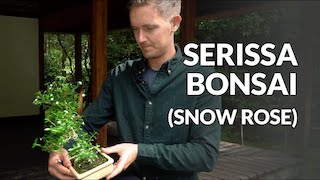Serissa Bonsai Care guidelines
The serissa likes a sunny, wind-protected place outside during the growing season as long as the night temperatures stay above 50° F / 10° C. Drastic temperature drops are not tolerated. Avoid unnecessary changes of the tree's position, but from autumn to spring the serissa must be placed in the house or a heated conservatory at temperatures between 50°F (10°C) and 68°F (20°C). The warmer the position the more light is needed. Grow lights can help. Try to provide high humidity.
Keep the rootball moist, but at the same time take good care not to overwater the serissa Bonsai tree. It must never dry out completely. If the tree drops its leaves due to some changes in the growing conditions, continue but slightly decrease watering. The serissa likes a neutral pH value (7), so avoid very calcareous water. When no flowers are on the tree, it is a good idea to often spray the foliage with lime-free water. Continue reading about watering Bonsai trees.
Watering
Free lecture from the Beginners CourseApply a small amount of solid organic fertilizer every four weeks or use a liquid fertilizer in a low concentration every week during the growing season. Use a fertilizer with a balanced N-P-K ratio. In winter fertilize once a month with a low dose of liquid fertilizer if the tree is kept in a warm place. Do not fertilize unhealthy or not growing serissas.
The serissa tolerates hard pruning which should be executed in early spring, if necessary. Young trees are trimmed back to 2 leaves when the shoots have produced 4 – 5 leaves. Older trees are trimmed less as long they are flowering, but are pruned thoroughly after flowering. Every two or three years the branches must be cut back to old wood in order to keep the tree shape compact. Branches and shoots can be wired at any time, but they are delicate and must be wired with great care. Remove the wire after approximately six months before it cuts into the bark. Continue reading about pruning Bonsai trees.
Repot the serissa every two years and use a standard soil mix. Prune the roots only moderately. The roots smell unpleasant when they are cut. Continue reading about repotting Bonsai trees.
The serissa can easily be propagated from semi-hardwood cuttings.
Aphids, root aphids or spider mites can attack the serissa. Use a specific pesticide and try to increase humidity. Overwatering or bad soil can cause root rot. Then repot the tree, cut off damaged roots and plant it in fresh, well draining soil. Try to improve the conditions for your tree. For more detailed information on these techniques, check out our Bonsai tree care section.

Serissa bonsai tree

Leaves of the Serissa

Snow rose Bonsai

Serissa foetida

Serissa in Chinese penjing style
General information about the Serissa Bonsai tree
The Serissa is an evergreen or semi-evergreen tree with fine oval, shiny green leaves. Foliage and roots have an unpleasant smell if damaged. Except for its lovely flowers, the serissa is valued for its fine ramification and rough grey bark.
The serissa is not easy to care for and better suitable for experienced growers because the tree is very sensitive to changes in location and temperature. The correct name of this tree is "Serissa japonica" but most people still use the old name 'Serissa foetida'. Serissa Bonsai do not tolerate frost and needs temperatures between 50°F (10°C) and 68°F (20°C) in winter. If you need help identifying your tree, take a look at our Bonsai tree identification guide.





